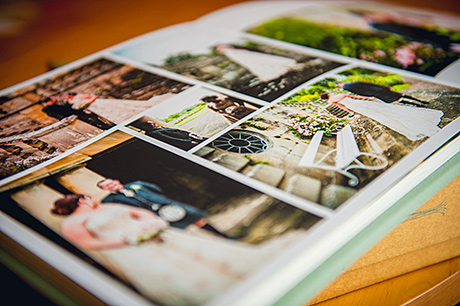Digital is brilliant for speed and convenience, but if you want to look back in years to come, nothing beats a proper album for your precious wedding photographs

Words by Holly Jones
We love stationery. Whether it’s an invitation or a thank-you card, there’s something about the feeling of quality paper under your fingertips that delights. An email, sadly, just can’t come close.
In today’s digital world, the same goes for photo albums. Certainly, when it comes to the instant sharing of news and snaps, nothing matches the ease and speed of an online update. When it comes to your wedding, however, printed keepsakes have greater significance than ever before.
“The digital age is a marvel, but nothing can beat the sensory stimulation of touching a beautifully crafted album,” says Paul Brown of PB Photography (p-b-photography.co.uk). “The visual impact remains, but the excitement of handling a finished album is second to none.”
So how do you go about putting a beautifully printed and perfectly presented set of images together? There’s no denying that it takes time to design, print and bind a wedding book, but, like all good things, it’s worth the effort.


1 DECISIONS, DECISIONS…
We know: there are so many decisions to be made as your wedding celebrations approach that asking you to make another one might seem a step too far. If you’d feel more comfortable postponing it, you can quite easily leave any album-related decisions until after the honeymoon. But, as photographer Craig McBeth (mcbethphotography.com) reminds us, while there are dozens of options in terms of size, shape, finish and price, your choice basically boils down to something altogether more simple.
“Essentially, albums can be separated into two types, which I refer to as ‘flush-mount’ and ‘matted’,” he says. A flush-mount album – otherwise known as a story book or coffee-table book – is, he explains, designed on computer and the photographs are printed directly on to the pages of the book. “It allows for an extremely flexible design – you can have images overlapping, large images crossing the centre seam, and images running right out to the edge of the page.
“Matted, meanwhile, is a new and improved version of the album your parents would have had. The photographs are printed and are fixed to the album pages and then a mat (a piece of card with a cut-out slightly smaller than the dimensions of the photo) is fixed on top to frame them and hold them in place. These tend to be more of a premium product, but they give you less flexibility in the layout.”


2 MATERIAL MATTERS
Things get a little more complicated when it comes to the finishing touches. Although your photographer will narrow down certain aspects of the package for you, you’ll need to decide on elements such as the book size, the cover (hardback or paperback) and the paper grade (will you have your images printed on glossy paper, matt paper or expensive, high-quality fine-art paper?).
“In fashion terms, these elements are like the difference between off-the-peg design and couture,” says Emma Lawson (emmalawsonphotography.com). “At the couture end, your photos will be printed on thick fine-art paper using superior techniques to produce images that won’t fade or discolour over time. Such albums are often bound in leather or silk, resulting in a tactile, high-quality product. At the off-the-peg end of the spectrum are coffee-table books. These tend to have thinner pages, similar to a magazine. They may not last quite as long as the couture albums but they are certainly a more cost-effective choice if you’re on a tight budget.”
At the end of the day it’s all down to personal preference and what matters to you. “Your photographer will have sample albums for you to look at, so take your time, feel the pages, touch the covers, decide what you like, and make the decision based on that,” she says.


3 THE BIG EDIT
So, the day is over. What next? “Designing an album is not about stuffing it with as many images as you can,” says Emma. “White space gives the pictures room to breathe. Don’t let the strength of your images be watered down by volume. Get rid of photos that aren’t serving a purpose or don’t play a key role in the story you’re telling.”
Don’t stuff your album with as many pictures as possible. White space gives them room to breathe
Paul agrees: “If you and your photographer get a little carried away, the result will be an album that looks cluttered, complicated and messy,” he says.
The message is: edit with care. Different photographers will have different approaches, but essentially once you have viewed all your final images from your day you’ll most likely be asked to select your album favourites. “Some photographers will give you guidelines about how many to choose from each part of the day, and then provide you with an electronic mock-up which you can review and suggest changes to. It’s a collaboration – or at least it should be.”
4 OPTIONAL EXTRAS
You’re not done yet. How about a framed print or a present for your new in-laws? “There are a lot of additions,” says Paul, “such as parent albums (usually a smaller-sized copy of the couple’s album), canvases, framed prints, DVD slideshows, copies of the proof preview book, acrylic blocks and aluminised prints.” Take your time and remember there’s no rush – most photographers will keep your images so you can order more as and when you need them.
When it comes to your core purchase – the album – Craig says it’s worth keeping things simple. “A quality album, beautifully bound in leather or silk, will be timeless,” he says. “You may cringe at the hairstyles in the photos when you look back in thirty years’ time, but your album will continue to look fabulous as it is handed down the generations and becomes a family heirloom.”







